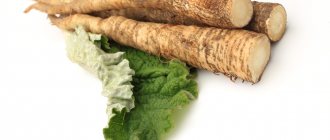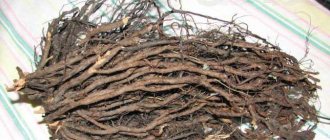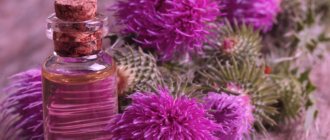History of chicory
The cultivation of the plant began in ancient Egypt. The Egyptians, followed by the Romans, ate green chicory leaves and added them to salads. Already in those days, people knew the beneficial properties of chicory. Its benefits for normalizing digestion and treating joint pathologies were especially noted.
Chicory tincture has long been used for medicinal purposes by the peoples of Asia, Indonesia, India, Africa, America and Europe. Since the mid-16th century, brewing the roasted roots of the plant has become a practice. The drink was consumed more actively than coffee.
Since ancient times, the plant has been used to prevent digestive diseases, normalize kidney and liver function, and improve metabolism in the human body. Chicory was recommended as a disinfectant to treat skin diseases, accelerate the healing of boils and wounds, and also as a diuretic.
In Russia, chicory became famous under Peter I. It is known that Peter sent residents of the village of Poreche-Rybnoye, Rostov district, to Holland to learn gardening. There they drank a chicory drink, which the king later liked. Industrial production of chicory was established in Porechye along with the cultivation of other vegetables for the royal table.
According to another version, one of the village residents learned how to grow and process chicory while working for the German Hackmann. Returning to his native village with a bag of seeds, he began to develop a new craft and achieved great success in this field. According to church records, it was Ivan Zolotakhin who donated 40 thousand rubles for cast silver gates to the Nikita Church in his native village.
Composition and name
The flowers contain chicory glycoside, the roots contain the carbohydrate inulin, protein substances, fructose, resin, organic acids, B vitamins (B1, B2, B3), vitamin C, minerals, and the milky juice contains bitterness. Inulin is a substance that helps improve metabolism and normalize the functioning of the digestive system.
The scientific name of the genus Cichorium comes from the Greek words kio - I go and chorion - alienated by the field, the name is due to the fact that the plant often enters the outskirts of fields. The specific name intybus is derived from the Latin words in - in and tubus - tube, given to the plant for its hollow stem. The Russian generic name chicory corresponds to the scientific name of the genus.
Useful properties of chicory
The plant contains many vitamins necessary for the human body:
- Vitamin E helps strengthen the immune system and slow down the aging process.
- Thiamine is necessary to stabilize the nervous system.
- Beta-carotene serves as a means of preventing cancer.
- Vitamin C is an excellent means of preventing flu and colds.
- Choline helps cleanse the liver of fatty deposits.
- Riboflavin has a positive effect on cellular processes and reproductive function.
- Pyridoxine can reduce the percentage of sugar in the blood, speed up metabolic processes, relieve a person from stress and relieve fatigue.
- Folic acid strengthens the heart and blood vessels and is necessary for the synthesis of amino acids and DNA in the body.
The root part of the plant contains about 75% inulin, which is necessary for diabetes. The organic polysaccharide is easily absorbed by the body and has a positive effect on the body’s defense system.
The beneficial properties of chicory are also expressed in its antimicrobial effects. The plant improves appetite, strengthens the immune system, and has a healing effect on the entire body.
chicory root medicinal properties
Habitat and ecology of chicory
Hemicryptophyte. Distributed in the European part of Russia, the Caucasus, Western and Eastern Siberia to Altai, Central Asia, Europe, North Africa. Common as a weed in crops, gardens, along roads, near ditches, on grassy slopes, ravines along river banks, in bushes, wastelands, waste places, along steppe ditches, in dry meadows, almost absent in the mountains, in some places it forms sparse thickets , however, it often grows in small groups especially on limestone, moist or moderately dry soils.
Chemical composition and calorie content of chicory
100 grams of product contains about 2% of the daily protein intake, about 6% carbohydrates, and no fats.
The calorie content is 21 kcal per 100 grams of product.
The chemical composition of the plant is very diverse. It includes a lot of useful vitamins, minerals, up to 15% sugars, astringents and tannins, ascorbic acid.
The flowers of the plant contain glycosides, and the seeds contain aldehydes. Bitter juice contains a large amount of astringents: taraxasthenrin, lactucin.
Inulin serves as a useful substitute for starch and sugar in the production of diabetic products.
Description and features
There are several types of chicory - mainly two cultivated and about 6 wild species with blue, light blue, bluish-pink and white inflorescences. In Russia, the most common chicory is the common chicory, Cichorium intybus L. - popularly called wild, roadside grass, blue flower.
This is a plant from the genus Chicory of the Asteraceae (Asteraceae) family, dicotyledonous class. Blue reed five-toothed flowers are collected in a rare basket, similar to a blue daisy, located 1 - 3 in the axils of the leaves. Flowers have an interesting feature: they open in the morning and close by noon, so you can tell the time by them.
A perennial herbaceous plant with milky sap in all its parts, it can reach a height of 60–120 cm, with a tap root up to 1.5 m long and an erect branched stem. The basal leaves are dissected, collected in a rosette, and the upper stem leaves are alternate, lanceolate, small sharp-toothed, stem-encompassing.
The grass blooms at the end of June after the summer solstice - as if it knows that the sun has turned to winter, and summer to the heat, and blooms until September; fruits are three-pentagonal bare achenes up to 2 mm long.
It grows almost throughout Russia on slopes, meadows, along the banks of reservoirs, along roads, near housing. The grass is harvested during flowering, the roots in early autumn.
Use of chicory in medicine
wild chicory, chicory root
The benefits of chicory allow it to be used in various fields of medicine. Traditional healers have long begun to use all parts of the plant for medicinal purposes:
- A decoction of chicory root is effective for colds and for increasing the body's protective functions.
- When mixed with chamomile, rose hips or motherwort, chicory is actively used to strengthen the cardiovascular system and prevent blood clots.
- A decoction of the roots of the plant is used to normalize the functioning of the digestive system, relieve inflammation and improve intestinal microflora.
- In folk medicine, chicory decoction is used to treat sinusitis as nasal drops.
- The drink helps you lose weight because it speeds up your metabolism.
- Fresh juice from the leaves of the plant is rich in iron, so it is recommended for anemia when mixed with fresh milk.
- For joint pain, chicory tincture will help relieve inflammation. They drink it a couple of times a day.
- The plant is actively used to treat skin diseases. The decoction is used for washing, lotions, and is also poured into the bath.
- Due to the benefits of chicory, it is used to strengthen hair and treat skin and nails.
Chicory root is actively used to treat liver diseases and is also used as a diuretic.
Application
Chicory root fiber contains inulin, a type of plant carbohydrate that cannot be broken down by digestive enzymes. It is typically produced by extracting inulin from chicory roots, resulting in chicory root extract.
Inulin is classified as a soluble fiber and a prebiotic. Soluble fiber retains water and expands in volume, thus increasing the amount of food you eat. This and its ability to retain moisture, creating creamy textures, is one of the reasons why fiber is so often used in recipes.
Inulin is found in many low-fat or lactose-free yogurts, ice cream and ready-made protein shakes.
In bread and other baked goods, inulin can be used as an alternative to gluten. Soluble fiber also helps increase the transit time of food through the gastrointestinal tract, which helps keep you fuller longer and stabilizes your blood sugar levels.
Ice cream, yogurt, protein shakes, low-carb, high-fiber energy bars, cereals, breads and granola often contain chicory root fiber. In addition to adding volume to the product, it makes it a little healthier by increasing the fiber content without adding extra calories.
Additionally, it is cheap to produce and has a naturally sweet taste. This is another feature that appeals to food manufacturers because chicory root sweetener can enhance the flavor of foods without the need for added sugar, calories or carbohydrates. Chicory is also an excellent addition to the ketogenic diet for those who want to lose weight quickly and also reduce their carbohydrate intake.
The pleasant taste and low cost of inulin are the reasons why it was used along with coffee during periods of shortage. By the way, this led to the development of the still famous New Orleans style coffee or chicory root coffee, which is a mixture of regular or decaffeinated coffee and chicory root powder.
Don't know where to buy chicory root fiber? Due to the growing popularity of this supplement, it can be found in many supermarkets and specialty health food stores. Chicory is also widely available in online stores.
Use of chicory in cooking
A drink made from the root of the plant often serves as an alternative to coffee. It should be noted that it does not have such a stimulating effect on the body, but invigorates and tones.
Chicory serves as a raw material for the production of high-quality alcohol and fructose, which replaces sugar. The green mass is used for fresh salads, added when stewing and baking vegetables, and baking muffins.
In Italy, chicory leaves are used in the preparation of pasta and risotto. Chicory perfectly complements dishes using eggs, fresh cucumbers, cheese, tomato paste, mayonnaise, and chicken breast. Chicory leaf is actively added to various dishes of European and Scandinavian cuisine.
Recipes
How to cook chicory at home:
- Store-bought pasta is simply poured with boiling water and drunk with the addition of milk, sugar, condensed milk, spices - whatever you like.
- The prepared raw materials are boiled in a Turk and poured with boiling water in a French press like tea.
- You can prepare kvass by fermenting raw materials.
To make the taste reminiscent of coffee, chicory root is roasted and crushed before brewing. No oil is used.
Interesting! In some countries, chicory root is added to first courses for flavor, chopped and added to casseroles and vegetable stews.
Chicory kvass
For 2.5 liters of boiled, cooled water:
- 150 g sugar;
- on the tip of a teaspoon ;
- 5 g baker's dry yeast;
- 2 tablespoons of store-bought chicory paste or 5 tablespoons of homemade roasted root powder.
How to cook:
- In a three-liter jar, mix sugar, yeast, chicory and citric acid.
- Add a liter of warm water - not boiling water, so as not to kill the yeast.
- Mix everything and shake, add the rest of the water.
- Place in a warm place - this could be a low-heat oven. The temperature should be around 27 degrees for fermentation to begin.
When active fermentation ends after 3 - 4 hours, you can strain the drink and put it in the refrigerator to cool.
How to select and store chicory?
chicory root
When purchasing, you need to pay attention to the composition of the product. Manufacturers often supplement chicory root powder with finely ground oats, barley or rye. In such a mixture, the properties of the healing product will not be so pronounced.
The product does not like moisture, so preference should be given to foil packaging rather than outdated paper containers.
Before purchasing, if possible, you should feel the powder in the bag. The presence of lumps and compactions will be a sign of a low-quality product. A strong aroma indicates the presence of artificial flavors.
Experts recommend giving preference to a liquid concentrate, since it is more difficult to mix other components into it.
When buying powdered chicory, you need to pay attention to its appearance. The powder should not have lumps or inclusions of a different color. The light shade of the product indicates a weak degree of roasting of the plant roots.
Dark color indicates a high degree of roasting. This has a positive effect on the taste of the drink, but its composition is poorer in nutrients.
The taste of a good quality drink is bright, rich, but with a hint of bitterness. It is generally accepted that the highest quality chicory is produced in France, Germany and the Yaroslavl region.
It is recommended to store the product in a dry and dark place. A glass or metal jar with a tight lid is used as a container.
How and when to harvest chicory roots
Chicory roots are harvested either in early spring or late autumn , when the above-ground part of the plant begins to die. It is at this time that the maximum amount of nutrients accumulates in the roots, because the plant is preparing for winter.
Since the roots of chicory are long, they are not pulled out, but dug up . Then the roots are cleared of soil, quickly washed in cold water, thin side roots are removed and laid out on the grass for initial drying.
Then the roots are cut crosswise into small pieces , and thick roots are also cut lengthwise before this.
The roots are laid out on cloth and dried in a ventilated area or under a canopy.
But it is still better to dry the roots in a dryer or oven at a temperature not exceeding 60°. The oven door must be kept half open to prevent the raw materials from steaming. When the roots break with a bang, stop drying.
Chicory for weight loss
The use of the plant for losing excess weight is due to two special components in its composition:
- inulin;
- intibin.
The first component accelerates the processing of glucose and sugar by the body and their elimination. This prevents the deposition of sugar in the body, which is one of the reasons for gaining excess weight.
Intibin has a positive effect on the functioning of the digestive system and intestines, which is good for the process of fat breakdown. Fat deposits are not formed in the body, and nutrients are absorbed much faster.
An additional advantage is the unique bitter taste of the drink, which suppresses the sense of taste and hunger.
One way to lose weight with instant chicory is to consume it regularly before meals. For 0.5 liters of water you need to brew 5 grams of powder, strain and drink 150 grams three times a day half an hour before meals. This will speed up the process of digesting food and reduce portions. However, for serious weight loss, it is necessary to add calorie control to the daily menu to this regimen. This will significantly affect the breakdown of accumulated fats and cleansing of the body.
You can drink instant chicory instead of tea or coffee. It should be taken into account that when sugar is added, the calorie content of the drink increases noticeably. If you have a goal to lose weight, you should drink chicory without added sugar.
how to brew chicory, chicory root
Coffee
To prepare an analogue of coffee, you need to take 2 teaspoons of roasted and crushed roots, add a glass of water and cook over low heat for 15 minutes. The color of the drink should be dark brown.
There is a way to cook chicory in a Turk: to do this, add 100 ml of water to a teaspoon of root crushed in a coffee grinder and put on fire. Next, the process is similar to how coffee beans are prepared. You can bring to a boil three times and remove the Turk from the heat. It turns out delicious if you add spices - cardamom or cinnamon.
Glasse
To prepare iced glass, prepare a regular drink in a saucepan or coffee pot, then pour it into cups and add ice cream. In summer, the liquid can be pre-cooled, then added ice cubes.
French
French chicory is a cocktail with the addition of coffee liqueur, caramelized sugar, and ground ginger. Whipped cream is used for decoration.
How to make chicory:
- Fry 2 tablespoons of sugar.
- Add a couple of tablespoons of water and ginger, simmer for 4 - 5 minutes to form a syrup.
- Make a drink from chicory (any kind) per liter of water.
- Combine syrup and drink.
- Pour 30 ml of liqueur and the resulting mixture into a glass.
Garnish with whipped cream.
In Latvian
In the summer heat, you can make a drink from chicory according to a Latvian recipe. To do this, prepare soluble or powdered root in 0.5 liters of water. Add 300 ml of fresh apple juice, 3 full tablespoons of honey, and the juice of half a lemon. The result is a vitamin cocktail that can be consumed by children and adults to boost their immunity.
Is chicory suitable for children and pregnant women?
Often during pregnancy, women replace coffee with chicory. This is not prohibited. Eating chicory provides additional benefits:
- The drink helps replenish iron levels in the blood.
- Chicory has a positive effect on blood vessels, heart, liver and kidneys.
- A cup of the drink will help cope with heartburn or nausea and normalize bowel function.
At the same time, pregnant women should not abuse the drink, as it can lower blood pressure.
When breastfeeding, experts allow a woman to drink two to three cups of the drink per week.
It is not recommended to give the product in its pure form to children under one year of age. At the same time, you should know that ready-made nutritional mixtures for babies may contain a minimum content of plant fibers. This is useful for the formation of beneficial bacteria in the baby's intestines. You should not add chicory to your child’s menu on your own.
It is allowed to accustom a child to drinking the drink after one year. Start the process with 10 grams of drink per day. You need to prepare a weak infusion. It is important to follow these rules:
- From the age of four, it is allowed to drink no more than 3 cups of drink per week.
- Younger schoolchildren can drink one cup of drink per day.
It is important to understand that you should not get too carried away with chicory.
Benefits of chicory for skin
benefits of chicory, chicory root
The rich composition of the plant has led to its widespread use in cosmetology. The properties of the plant help:
- get rid of acne, diathesis and age spots;
- activate skin cellular processes;
- cure pustular rash, psoriasis, eczema;
- rejuvenate the skin;
- accelerate skin regeneration.
Benefits of chicory for the stomach and digestion
chicory root
Chicory decoction has a positive effect on the digestive system. Regular consumption of the product tidies up the intestinal microflora,
supplementing it with beneficial bacteria. This helps speed up the process of digestion and removal of toxins from the body, and also speeds up the absorption of nutrients by the body.
The drink copes with constipation and has a positive effect on appetite. Chicory is recommended as a useful anti-inflammatory agent for peptic ulcers of the gastrointestinal tract.
Insulin, present in the plant, promotes the growth of beneficial microflora, being a natural bifid stimulant.
Thanks to its beneficial properties, chicory has found use in the prevention and treatment of diseases of the pancreas, intestines, stomach and liver.
Harm of chicory to the body
There are no contraindications to the use of chicory as such, but it should be taken with caution by people suffering from:
- liver diseases,
- respiratory system (chronic bronchitis, cough, asthma),
- gastrointestinal tract (gastritis, ulcer),
- urolithiasis,
- allergies.
People with a history of varicose veins, vascular disease, hemorrhoids, thrombophlebitis, asthma, bronchitis, and chronic cough should be careful. Due to the high content of vitamin C, chicory can cause aggravation of allergies.
When used simultaneously with antibiotics, their absorption in the gastrointestinal tract may be reduced. Therefore, it is better not to combine them with each other.
Particular attention should be paid to the quality of the product. Thus, if the quality of raw materials is low, unscrupulous manufacturers can add apple pectin instead of inulin and artificially enrich the drink with vitamins.
Chicory tea
It is recommended to drink as an emollient for sore throat, inflammation of the respiratory organs, and difficulty urinating. It is good to combine it with green tea and anise.
Chicory is effective as a tonic for general weakness and loss of strength, and painful sweating. It is useful for patients with diabetes. Dry, fried and ground chicory roots are used instead of coffee, or as an additive to coffee; it is especially useful for hypertensive patients.
Chicory herb is also used externally, festering wounds and boils are washed with a decoction, and for skin rashes, boils, carbuncles, it is useful to additionally drink an infusion of chicory root.
For eczema and gland tumors, it is recommended to make compresses from an infusion of the root.
use of chicory
Decoction of chicory leaves or herbs
Pour 1 teaspoon of crushed leaves into 1 glass of boiling water, boil for 15 minutes, set aside and leave for 45 minutes, strain. Drink during the day for the above diseases.
To treat boils and swelling, chicory root pulp is used externally. Chicory root is also used in traditional medicine for hysteria, hypochondria, asthenia and anemia.
For abdominal pain caused by a disease of the stomach or intestines, apply a compress from a decoction of fresh chicory leaves. The same compresses have a healing effect, relieve inflammation and pain from bruises and injuries.
With all the benefits of chicory, you also need to remember that you can’t overuse chicory; you can drink one cup of tea a day without harm, but with more frequent use, problems may arise, especially for sensitive people.
Chicory is also a valuable industrial crop and is widely used in the distillery and confectionery industries.
Risks and side effects
Scientists still have a lot of research to do on fiber and chicory root extract. And while research shows that chicory root fiber has some health benefits, it's always best to get this fiber from whole foods.
If you have any medical conditions, be sure to consult with your doctor before adding chicory or chicory root supplements to your diet. Chicory coffee is not recommended for pregnant women as it can cause menstrual bleeding and miscarriage. ()
It is also possible to have an allergy to chicory, accompanied by symptoms such as hives, rash, itching and swelling. If any of these symptoms occur, stop taking the supplement immediately and contact your doctor.











